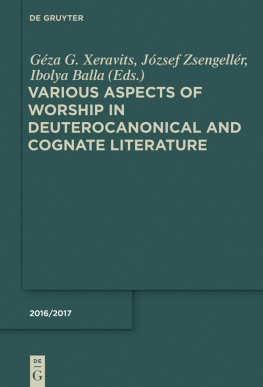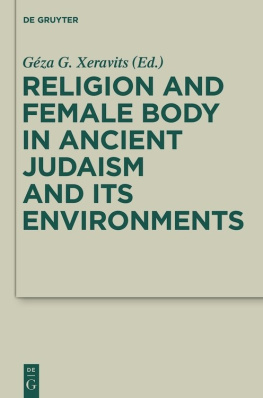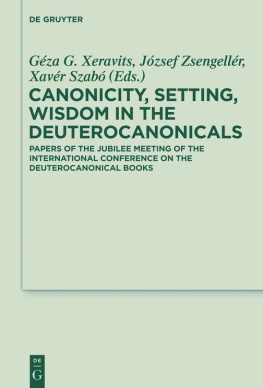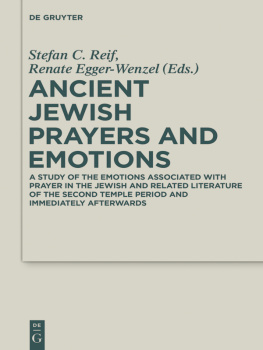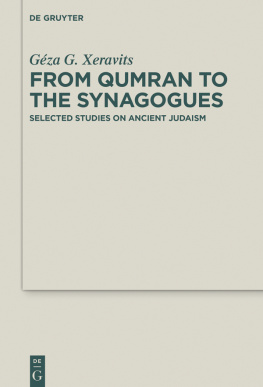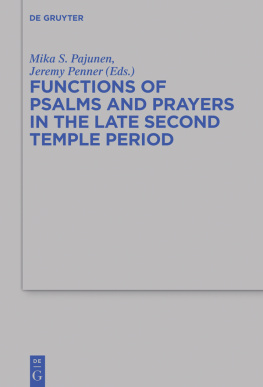Contents
Guide

Deuterocanonical and Cognate Literature
Yearbook 2016/2017
Deuterocanonical and Cognate Literature

Edited by
Nria Calduch-Benages, Jeremy Corley,
Michael Duggan and Renate Egger-Wenzel

ISBN 978-3-11-046564
e-ISBN (PDF) 978-3-11-046740-6
e-ISBN (EPUB) 978-3-11-046656-0
ISSN 1614-3361
Library of Congress Cataloging-in-Publication Data
A CIP catalog record for this book has been applied for at the Library of Congress.
Bibliographic information published by the Deutsche Nationalbibliothek
The Deutsche Nationalbibliothek lists this publication in the Deutsche Nationalbibliografie;
detailed bibliographic data are available on the Internet at http://dnb.dnb.de.
2017 Walter de Gruyter GmbH, Berlin/Boston
www.degruyter.com

To Jacques Vermeylen
Preface of the Editorial Board of Deuterocanonical and Cognate Literature Yearbook
This volume of papers from the Budapest conference of 2015 represents the first example of adjustments that we have made in the editorial conventions of the Deuterocanonical and Cognate Literature Yearbook. As editors we wish to point out some essential features in the extensive editing that we have done on this volume.
This collection of papers marks the initial implementation of our decision to adopt The SBL Handbook of Style Second Edition (Atlanta: SBL Press, 2014 for the composition and editing of all papers in the DCLY. We made this decision in order to ensure that the DCLY adheres to the international standards of biblical scholarship.
We devoted unprecedented time and energy to editing the papers from the Budapest conference. Nevertheless, we lacked sufficient resources of time and personnel to adhere to all the conventions of the SBLHS 2nd edition in this volume. We accepted each authors preference for the spelling conventions of English either in the UK or USA. Our editorial decisions resulted in some inconsistencies in this transitional volume of papers.
The provision of a bibliography at the end of each article is the only feature that will remain distinctive of the DCLY vis--vis the SBLHS 2nd edition . Nevertheless, the footnotes and bibliography will conform to the conventions of the SBLHS 2nd edition . Our abiding principle is that the bibliography should contain only those works that are referenced in an article. In due course the editors will issue a style sheet for applying the SBLHS 2nd edition to the DCLY. This style sheet will be published on the ISDCL/DCLY homepage (https://www.uni-salzburg.at/index.php?id=21361).
We are particularly concerned to enhance the quality of composition in the articles. We express our admiration for authors who are not native English speakers but whose writing meets the academic standard of quality prose at a university level. We want to encourage all scholars to attain this standard. To that end we shall insist that a scholar who lacks facility with English composition must submit his or her paper for editing by a colleague who possesses the required expertise in English prose. The object of the procedure is to ensure that each sentence clearly communicates the scholars insights to the reader.
We appreciate the collaborative efforts of Dr. Albrecht Dhnert, our editorial director at De Gruyter, and the members of the International Society for the Study of Deuterocanonical and Cognate Literature for their important contributions to the enhancement of the DCLY.
Prof. Dr. Nria Calduch-Benages
Dr. Jeremy Corley
Prof. Dr. Michael W. Duggan
Prof. Dr. Renate Egger-Wenzel
(editors DCLY)
Preface
This volume is based on papers read at the 2015 biennial international conference of the International Society for the Study of Deuterocanonical and Cognate Literature (ISDCL), held in Budapest from 28 June to 1 July 2015. The editors are grateful to the leaders of the Society for their decision made during the 2013 Berlin Conference to give Kroli Gspr University of the Reformed Church in Hungary and Sapientia College of Theology the opportunity to organise the prestigious event. They also wish to express their gratitude to Walter de Gruyter Publishing House for publishing the papers of the conference and especially to Dr. Albrecht Dhnert and Stefan Selbmann for their constant support during the production of the book.
The contributions explore various aspects of worship as reflected in the literature of Judaism from the Second Temple period to Late Antiquity. The volume provides a fresh reading of various important issues especially within Old Testament Apocrypha and Pseudepigrapha, rabbinic literature, gnostic traditions, and the emerging synagogue. The papers analyse texts and artefacts that reveal how various groups of Judaism understood the concept of worshipa pre-eminent form of expressing religious identity and interpreting fundamental traditions.
It is an especial honour for the editors that Prof. Karin Schpflin (Gttingen), Prof. Dr. Dr. h.c. mult. Otto Kaiser (Marburg), and the Ehrenprsident of the Society, Prof. em. Friedrich V. Reiterer (Salzburg) considered it important to contribute to the volume.
During the earliest stages of organising the conference, a regular contributor of the biennial ISDCL meetings, Prof. Jacques Vermeylen was very enthusiastic about joining the participants. Sadly enough, his untimely death at the age of 71 (which occurred on 3 November, 2014 prevented him from actually participating in the conference. As a small token of gratitude, we dedicate this book to the memory of this warm-hearted and inspiring colleague.
Gza G. Xeravits
Jzsef Zsengellr
Ibolya Balla
(editors)
Stefan C. Reif
How did Early Judaism Understand the Concept of Avodah ?
Abstract: The Hebrew word avodah has an intriguing semantic history. Early Rabbinic texts presuppose meanings that include work, study, Temple worship and prayer. Do these nuances have a respectable linguistic pedigree, or did the Rabbis invent them? In order to respond to this question, an assessment will be offered of how the word is defined in Classical Hebrew and in the Hebrew texts of the Dead Sea Scrolls. These findings will then be compared with how the word was rendered by those who translated the Hebrew Bible into Greek for the Septuagint, and by the grandson of Ben Sira. It will then be possible to offer a tentative analysis of how theology appears to have influenced language in the treatment of this word by the Jews of the Second Temple period.
Keywords: Classical Hebrew; Rabbinic Hebrew; Septuagint; Dead Sea Scrolls; theology
1Introduction
In order to tackle the topic in hand it will be necessary to examine the Hebrew and Greek sources that reflect the manner in which the Jews of the Second Temple period used their languages to give expression to the relevant religious ideas, whether these represented inherited traditions, or their own innovative notions. To that end, the standard dictionaries of the Hebrew Bible will be closely examined for indications of what was conveyed by the term avodah and their conclusions will be critically compared with the linguistic evidence available from the Dead Sea Scrolls. This comparison will be followed by a close analysis, by way of numerous biblical verses, of how the Jews who translated the Hebrew Bible into Greek rendered the word avodah , and an examination of what some of the apocryphal (or Deuterocanonical) texts have to offer in this connection. What should then become apparent is the degree to which linguistic usage and religious ideology impacted on each other within the dynamic cultural developments that characterized Jewish history in the centuries being discussed. If the question is raised as to why the linguistic evolution is so important to our proper understanding of a theological notion, my reply would be that without the use of accurate linguistic and literary tools, the reconstruction of a cultural

